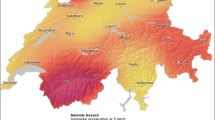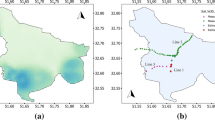Abstract
A fully probabilistic seismic risk analysis using a comprehensive approach is conducted for Medellin, the second largest city of Colombia, using a building by building database constructed and complemented from aerial images, considering characteristics such as building use categories, socio-economic levels and replacement values. The seismic hazard used for the analysis corresponds to the most updated study available in the country with the same model that was included in the national building code maps definition. Spectral transfer functions are determined for each of the seismic microzonation zones in order to take into account the dynamic soil response and amplification effects in the risk analysis. Several building types are defined for the city and individual vulnerability functions are assigned to each of them. Risk results are presented in the state of the art metrics such as the loss exceedance curve, probable maximum losses for different return periods, average annual losses and risk maps. The obtained results can be classified by use and socio-economic sectors as well as by structural systems that may help the stakeholders to identify where the risk concentrates.















Similar content being viewed by others
Notes
Comprehensive approach to probabilistic risk assessment (www.ecapra.org).
References
Alcaldía de Medellín (2010) Geonetwork. http://poseidon.medellin.gov.co/geonetwork/srv/es/main.home. Accessed 12 Jan 2013
Alcaldía de Medellín (1994) Estudio de la amenaza, zonificación, análisis y vulnerabilidad sísmica para Medellín
Andersen TJ (2002) Innovative financial instruments for natural disaster risk management. Technical paper, Inter-American Development Bank
Asociación Colombiana de Ingeniería Sísmica-AIS (1984) Estudio General del Riesgo Sísmico de Colombia
Asociación Colombiana de Ingeniería Sísmica-AIS (1996) Estudio General de la Amenaza Sísmica de Colombia. Comité AIS-300
Asociación Colombiana de Ingeniería Sísmica-AIS (2010a) Estudio General de Amenaza Sísmica de Colombia. Comité AIS-300
Asociación Colombiana de Ingeniería Sísmica-AIS (2010b) Reglamento Colombiano de Construcción Sismo Resistente, NSR-10. Comité AIS-100
Cardona O (2009) La gestión financiera del riesgo de desastres: Instrumentos financieros de retención y transferencia para la Comunidad Andina. PREDECAN, Lima, Perú
Cardona O, Hurtado J (2000) Holistic seismic risk estimation of a metropolitan center. Paper presented at the 12th world conference on earthquake engineering, Auckland, New Zealand
Carreño M, Cardona O, Barbat A (2007) Urban seismic risk evaluation: a holistic approach. Nat Hazards 40(1):137–172
Cardona O, Ordaz M, Reinoso E, Yamín L, Barbat A (2010) Comprehensive approach to probabilistic risk assessment (CAPRA); international initiative for disaster risk management effectiveness. In: 14th European conference on earthquake engineering, Ohrid, Macedonia
Carreño M, Cardona O, Barbat A (2012) Holistic evaluation of the seismic urban risk using the fuzzy sets theory. Bull Earthq Eng 10(2):547–565
Cornell A (1968) Engineering seismic risk analysis. Bull Seismol Soc Am 58(5):1583–1606
Esteva L (1970) Regionalización sísmica de México para fines de ingeniería. Universidad Nacional Autónoma de México, Instituto de Ingeniería
Evaluación de Riesgos Naturales América Latina-ERN-AL (2009) Informe Técnico ERN-CAPRA-T1-5. Vulnerabilidad de edificaciones e infraestructura
Evaluación de Riesgos Naturales América Latina-ERN-AL (2010) Comprenhensive approach to probabilistic risk assessment. http://www.ecapra.org. Accessed 15 May 2013
Evaluación de Riesgos Naturales América Latina-ERN-AL (2011a) CAPRA-GIS v2.0. Program for the probabilistic risk assessment. Available on http://www.ecapra.org. Accessed 15 May 2013
Evaluación de Riesgos Naturales América Latina-ERN-AL (2011b) Efectos de sitio. Local site effects computing program
Freeman P, Keen M, Mani M (2003) Dealing with increased risk of natural disasters: challenges and options, vol 8, 2003–2197. International Monetary Fund. Fiscal Affairs Department
Gallego M (2000) Estimación del riesgo sísmico para Colombia. Universidad Nacional Autónoma de México, México City, México
Instituto Geográfico Nacional-IGN (2013) Actualización de mapas de peligrosidad sísmica de España 2012. Ministerio de Fomento, Gobierno de España
International Strategy for Disaster Risk Reduction-ISDR (2013) Global assessment report on disaster risk reduction 2013. Switzerland, Geneva
Jaramillo J, Ortega D (1994) Estudio del riesgo sísmico de Medellín. Univeresidad EAFIT, Medellín, Colombia
Kellogg J, Vega V (1995) Tectonic development of Panama, Costa Rica and the Colombian Andes: constraints from global positioning system geodetic studies and gravity. Geol Soc Am Special Paper 295:75–90
Marulanda M (2013) Modelación probabilista de pérdidas económicas por sismo para la estimación de la vulnerabilidad fiscal del Estado y la gestión financiera del riesgo soberano. Tesis Doctoral, Barcelona, España. Universidad Politécnica de Cataluña, UPC
Marulanda M, Cardona O, Ordaz M, Barbat A (2008) La gestión financiera del riesgo desde la perspectiva de los desastres: evaluación de la exposición fiscal del estado y alternativas de instrumentos financieros de retención y transferencia del riesgo. Monografía, CIMNE IS-61. Barcelona, Spain
Marulanda M, Carreño M, Cardona O, Ordaz M, Barbat A (2013) Probabilistic earthquake risk assessment using CAPRA: application to the city of Barcelona, Spain. Nat Hazards. doi:10.1007/s11069-013-0685-z
McGuire R (2004) Seismic hazard and risk analysis. Earthquake Engineering Research Institute, Oakland
Miranda E (1999) Approximate seismic lateral deformation demands in multistory buildings. J Struct Eng 125(4):417–425
Ordaz M (2000) Metodología para la evaluación del riesgo sísmico enfocada a la gerencia de seguros por terremoto. Universidad Nacional Autónoma de México, México, DF
Ordaz M, Aguilar A, Arboleda J (2007) CRISIS. Universidad Nacional Autónoma de México, Program for computing seismic hazard. Instituto de Ingeniería
Panzera F, Lombardo G, Rigano R (2011) Use of different approaches to estimate seismic hazard: the study cases of Catania and Siracusa, Italy. Boll Geofis Teor Appl 52(4):687–706
Paris G, Machete M, Dart R, Haller K (2000) Map and database of quaternary faults and folds in Colombia and offshore regions, USGS open-file report
Pulido N (2003) Seismotectonics of the Northern Andes (Colombia) and the development of seismic networks. Bull Int Inst Seismol Earthq Eng (special edition):69–76
Ramírez J (2004) Actualización de la historia de los terremotos en Colombia. Pontificia Universidad Javeriana, Bogotá, Colombia
Ramana C, Dogagoudar G (2012) Seismic hazard analysis using the adaptive Kernel density estimation technique for Chennai City. Pure Appl Geophys 169:55–69. doi:10.1007/s00024-011-0264-8
Salgado M, Bernal G, Yamín L, Cardona O (2010) Evaluación de la amenaza sísmica de Colombia. Actualización y uso en las nuevas normas colombianas de diseño sismo resistente NSR-10. Rev de Ing 32: 28–37. Universidad de Los Andes, Bogotá, Colombia
Salgado M, Zuloaga D, Cardona O (2013) Evaluación probabilista del riesgo sísmico de Bogotá y Manizales con y sin la influencia de la Caldas Tear. Rev De Ing 38:6–13. Universidad de Los Andes, Bogotá, Colombia
Shedlock KM, Tanner JG (1999) Seismic hazard map of the western hemisphere. Ann Geofis 42(6):1199–1214
SIMPAD, Universidad EAFIT, Integral, INGEOMINAS, Universidad Nacional de Colombia Sede Medellín (1999) Instrumentación y microzonificación sísmica del área urbana de Medellín
Taboada A, Rivera A, Fuenzalida A, Cisternas A, Philip H, Bijwaard H, Olaya J (2000) Geodynamics of the northern Andes. Subductions and intracontinental deformation (Colombia). Tecton 19(5):787–813
Zuloaga D (2011) Implicaciones de la estimación del riesgo sísmico de Bogotá como resultado de una nueva interpretación sismo-tectónica. Universidad de Los Andes, Bogotá, Colombia
Acknowledgments
The authors are grateful for the support of the Ministry of Education and Science of Spain “Enfoque integral y probabilista para la evaluación del riesgo sísmico en España”— CoPASRE(CGL2011-29063). Also to the Spain’s Ministry of Economy and Competitiveness in the framework of the researcher’s formation program (FPI).
Author information
Authors and Affiliations
Corresponding author
Rights and permissions
About this article
Cite this article
Salgado-Gálvez, M.A., Zuloaga-Romero, D., Bernal, G.A. et al. Fully probabilistic seismic risk assessment considering local site effects for the portfolio of buildings in Medellín, Colombia. Bull Earthquake Eng 12, 671–695 (2014). https://doi.org/10.1007/s10518-013-9550-4
Received:
Accepted:
Published:
Issue Date:
DOI: https://doi.org/10.1007/s10518-013-9550-4




